





PHOTO GALLERY

Photos by Len Blumin
1. Snowy Plover - Charadrius alexandrinus
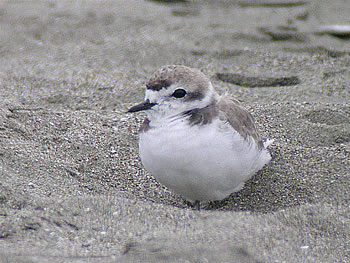
The Snowy Plover (Charadrius alexandrinus) likes sandy beaches, where they hang out well above the shoreline, often hiding in a natural depression. They are easily overlooked and don't readily flush, which explains perhaps their ability to survive on beaches crowded with people and dogs. This one was part of a small flock at Doran Beach (Bodega Bay), about 75 years south of the main parking lot. Rich S. had the group detour above them, while I walked along the shore for a better view. The birds ignored us of course, confident of their hiding places. In breeding plumage, as see here, the forehead, auriculars and neck patch are darker. Our smallest plover, at 6.25" and weighing 1.4 oz.
2. Phalarope Migration
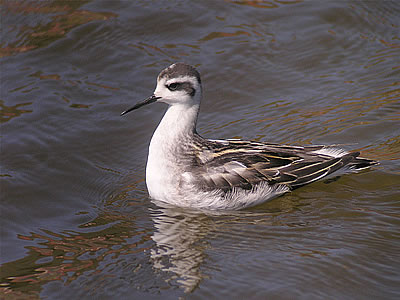
The Phalaropes are on the move. The Red-necked Phalaropes (Phalaropus lobatus) breed up in the Artic Tundra and then head south in the summer. Females leave first, shortly after laying the eggs. The male broods the eggs, looks after the chicks as they forage, and then heads south. The juveniles are then on their own and are the last to head south, destined for oceanic wintering grounds.Along the way they stop at both marine and fresh-water habitats to catch prey to fuel their trip. Right now juvenile Red-necked Phalaropes can be seen in many locations, such as Bodega Bay, Point Reyes (Drakes Beach), Rodeo Lagoon, etc. Many are found further inland, on waters such as Mono Lake. This juvenile, with black cap, thin bill, black "comma" behind the eye, and rufous stripes on the back, was photographed a few days ago at Rodeo Lagoon, in that little extension at the northwest corner (near the bridge).
3. Surfbird - Aphriza virgata
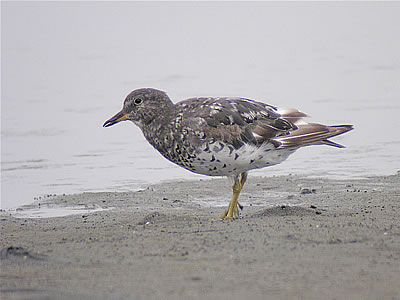
Summer at Doran Beach (Bodega Bay), incoming tide, and morning light. It doesn't get much better hereabouts for watching shorebirds, now returning from more northern breeding grounds. The world population of Surfbirds is about 100,000, and the whole lot of them breed on stony alpine tundra in Alaska and the Yukon Territory. They depart in June, looking for a wintering spot on the Pacific Coast, and may stop anywhere from Alaska all the way down to Chile, but pretty much always found in a narrow band within a few meters of the high tide line. Seldom seen inland, except perhaps for spots like the Salton Sea. We are lucky that a favorite spot for them to fatten up on their journey south is Bodega Bay, where as many as several hundred can be seen foraging on the tidal mudflats, or roosting above the high tide line. Often found on rocks, like the Rock Sandpiper, Wandering Tattler, and Black Turnstone, but Surfbird can also feed on sandy shorelines like a Sanderling. Used to be grouped with the Turnstones, but thought now to be more closely related to the knots, especially the Great Knot. See SE Senner and BJ Mccagrey's account in Birds of North America.
This individual appears to be a worn alternate plumage adult, whose beautiful salmon-colored scapulars have worn, and the molt to basic plumage has likely begun. Note the stout short bill, with yellow at the base of the lower mandible, and of course the yellow legs. The photo doesn't quite match the guidebooks, but Paulson's "Shorebirds" shows a similar bird.
Taxonomy:
Order: Charadiiformes
Family: Scolopacacidae - The Shorebirds
Sub-family - Calandrine Sandpipers - Smaller sandpipers, Stints, Knots, Sanderling, Ruff and
Surfbird
Genus: Aphriza - name coined by JJ Audubon, apparently meaning "living in the sea foam". One
species.
Species: Aphriza virgata - Surfbird. Nothing quite like him. In basic plumage he looks a bit like the
Black Turnstone, but the bill and legs quickly separate them.
4. Grasshopper Sparrow - at last!
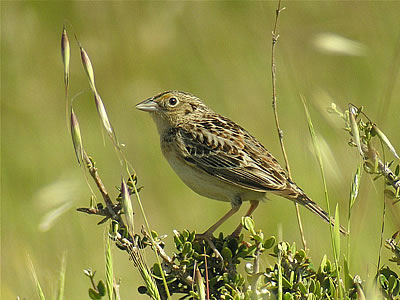
Perhaps like me, you thought that Grasshopper Sparrow (Ammodramus savannarum) gets its name from a favored prey item. And then you may have thought, well, sparrow eat seeds, so.....? Yep, the name comes from their song, which is said to bear a remarkable resemblance to the stridulations of the Meadow Grasshopper (Terres). Found this one today on Mt. Burdell, thanks to a tip from Daniel Edelstein. Taken at 9:30 am, in the area where the Lewisia is found. Enter at the San Carlos trailhead to Mt. Burdell, head west along the fireroad, and then bear right as you go down the hill. Look for the serpentine outcrops on the right and listen for a grasshopper! They tend to stay hidden in the grass unless they are singing. The "song", such as it is, has a few high introductory chips, followed by a distinctive buzz. I liked this photo because of the way it depicts some of the field marks, namely the "flat head" (straight line from the bill back to the crown), white eye ring, orange spot in front of the eyes, unstreaked breast with a little buffy color, and the suggestion of a light crown stripe, better seen in other photos.
5. Indigo Bunting - Passerina cyanea
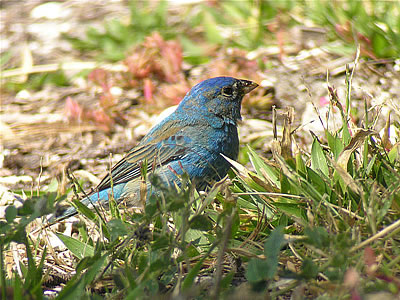
Sometimes I envy birders in the east and mid-west, not only for their migrating warblers, but also for species such as the Indigo Bunting (Passerina cyanea). On our visit to Ft. De Soto Park in April, we watched this male Indigo Bunting foraging in an open grassy area. Clearly a male, but I'm not sure if it is a first year male or an adult that has not completed the molt into breeding plumage. First year male perhaps more likely. Birds of North America says that these young males can be highly variable in their plumage, and that the color is not always bilaterally symmetrical. Indigo Buntings are sighted with some regularity in California, including Marin County.
Won't try to recount the confusing (to me) taxonomy of the Buntings/Grosbeaks/Cardinals, et. al., but suffice to say that the Passerina genus in the U.S. includes the Blue Grosbeak, plus the Lazuli, Indigo, Varied and Painted Buntings. The Blue Bunting is in the genus Cyanocompsa, and most of our grosbeaks are in the genus Pheucticus. Will again suggest reading C. Thompson's account of Cardinals & Allies, in Sibley Guide to Bird Life and Behavior.
6. Scarlet Tanager: Piranga olivacea
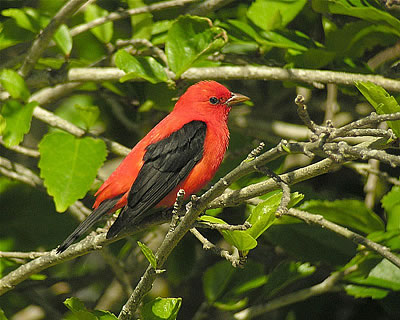
As a teenager I had a fantasy of some day owning a red and black corvette. The closest I got was owning a red Alfa Romeo Sprint coupe, but now I've photographed a bird that looks like my dream car of earlier days! Taken in Fort De Soto Park, Florida (Gulf Coast), April 16, 2008. These strong fliers easily cross the Gulf of Mexico.
The male Scarlet Tanager (Piranga olivacea) is the one of the most recognizable birds in the eastern half of the United States. It is said to be the longest migrant of all tanagers, wintering as far south as Peru and returning the the Eastern U.S. and southern Canada to breed. The Scarlet Tanager is mainly an insectivore, but also eats some berries and buds. It is monogamous, and aggressive on breeding territory towards other males. Female does all the incubating, and is sometimes fed by the male. By 9 days of age the chick is 70% of adult weight, and leaves the nest by age 10-11 days. Song is said to be like a hoarse burry American Robin. Population of species said to be stable, but vulnerable to Brown-headed Cowbird.
Taxonomy (this seems to change every few years, so excuse the errors of my research)
Order: Passeriformes - Perching birds, or songbirds.
Family: Thraupidae - Tanagers and allies. Other related families include Cardinals/Gosbeaks, Sparrows, and even the Blackbirds. Sure wish we had more tanagers here, as there are 254 species in 65 genera. Good selection in Central America, but the rain forests of South America are supposedly filled with Tanagers (Ecuador, et. al.). Some day... We have only six species of Thraupidae in the U.S., in two genera.
Genus: Piranga - 9 species in all. The four species seen in the U.S. are Hepatic, Summer, Western, and Scarlet Tanagers -- all of them show-stoppers.
Species: Piranga olivacea - Scarlet Tanager. Latin name refers to the color of the female. According to Holloway (Dictionary of Birds of the U.S.) the word "tanager" is from the Tupi Indian word "Tangara", for similar birds in their area in Amazon Basin.
7. Young Whimbrel
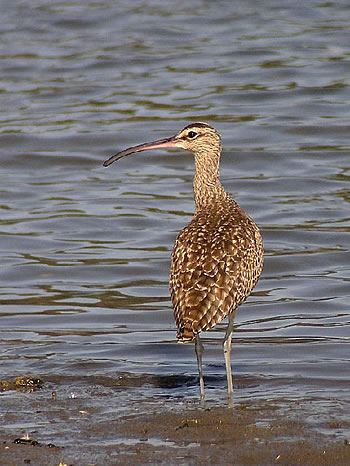
The Whimbrel (Numenius phaeopus) is a large shorebird in the Curlew group (taxonomy below). Whimbrels breed up in the tundra, then migrate south to their wintering territory, which may be well down in South America. We saw many on the west coast of Mexico and Costa Rica. Good numbers winter in the bay area, though seen usually as solitary guardians of favored a shoreline mudflat. There is one prominent site on Bolinas Lagoon near the Harbor Seal haul-out that some call Whimbrel Point, because of the reliable presence of a single Whimbrel stationed there. Whimbrels can be pretty aggressive, and won't hesitate to chase or poke birds that invade their foraging territory. They love crabs, but will also dine on sea worms and clams.
I found this bird in Bodega Bay near the Spud Point Marina November 9. Perhaps a first year bird, as it was less wary than the typical adult Whimbrel, which is often skittish around bipeds. The fresh looking feathers are particularly attractive in this rear view. Adults this time of year can also look pretty fresh. Boldly striped head, but central crown strip barely seen here.
Taxonomy:
Order: Charadriiformes - Shorebirds, Gulls, Terns, Alcids, etc..16 families all together.
Family: Scolopacidae - Sandpipers and allies. Big family, with 87 species worldwide.
Subfamily/Group: Curlews, one of 9 subfamilies making up the Scolopacid family. About 7 species of Curlews at this time, with the Eskimo Curlew now likely extinct. (last documented sighting in 1963).
Genus: Numemius - The Curlews, which are large to very large shorebirds. Besides the Whimbrel, we have Long-billed, Bristle-thighed, Eurasian, Far Eastern, Slender-billed, and Little Curlews. Whimbrel is the only Curlew that lacks the word Curlew in its common name.
Species: Numenius phaeopus - Whimbrel.
8. Greater and Lesser Yellowlegs compared
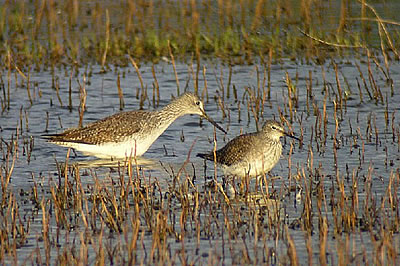
There is one easy way to tell the Greater Yellowlegs (Tringa melanoleuca) from the Lesser Yellowlegs (Tringa flavipes): just find them standing next to each other. These were seen on a wonderful outing to the delta last weekend led by Terry Colburn for the MDAS. Highlights of the trip for some were the Ferruginous Hawks, or perhaps 2 Pacific Golden Plovers, but I got a real kick out of seeing 3 Redhead ducks, followed soon thereafter by a flock of 100+ Greater Yellowlegs with a smattering of Lessers thrown in the mix. It was getting dark, but the sun suddenly poked through the low clouds to give enough light for a distant photo.
As you can see, the Greater Yellowlegs, as big as a Willet, is considerably larger than the Lesser, who is more Dowitcher-sized. Differences in posture here exaggerate the size of the Greater, but the more important features shown are the size, shape, and color of the bills. The Lesser YL's bill is black, thin at the base, and about as long as the apparent size of his head. The bill of the Greater YL is gray and thick at the base, and clearly longer than its head. When we see a Yellowlegs by itself we are well served to look carefully at the bill. Voice helps too, as the Greater cries out quite loudly in flight 3-4 times in succession, while Lesser gives a softer 1-2 note cry.
Taxonomy (after Nils and Sarah Warnock, in Sibley Guide)
Order: Charadriiformes - Shorebirds, Gulls, Terns, Alcids, etc.
Family: Scolopacidae - Sandpipers, Phalaropes, etc. Includes Snipe, Woodcock, Turnstones. Said to be the largest family in Charadriiformes, with 81 species in 21 genera. Fully 43 Scolopacids are seen in North America (hey, you may have to go to the Aleutians for some....).
Group (sub-family/tribe): Tringine Sandpipers - Over 20 (?) species worldwide, seven of which are seen in North America: Greater and Lesser Yellowlegs, plus Spotted Redshank, Willet, Wandering Tattler, Solitary Sandpiper and Spotted Sandpiper. Most seem to have a white eye-rings and longer legs. (I'm still waiting for the Redshank!)
Genus: Tringa - Includes most of the Tringine sandpipers, but not all. Willet is now a Tringa, but Spotted Sanpiper and Wandering Tattler are sometimes put in other genera within Trigine group. Tringa genus has about 15 species worldwide.
Species: Tringa melanoleuca (Greater Yellowlegs), Tringa flavipes (Lesser Yellowlegs).
9. Lapland Longspur
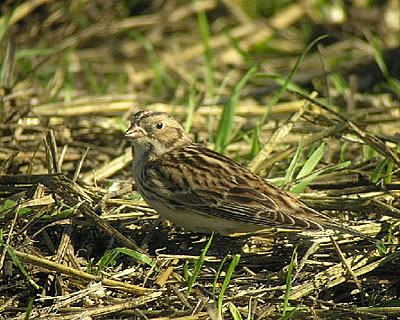
Glorious day on the Outer Point today with Rich Stallcup. Needless to day Rich found the flock of Longspurs, along with Long-tailed Duck, Black Scoters, Pacific Golden Plovers and about 66 other species.
Lapland Longspurs (Calcarius lapponicus) were the highlight for many, as changed agricultural practices make them less common at the Outer Point (Point Reyes National Seashore) and along the coast in general. Named for the long toe-nail ("spur") on their rear-pointing toe, Longspurs are in the New World Sparrow Family. There are 4 Longspurs, with the Lapland by far the most numerous. Lapland Longspur breeds worldwide across the northern tundra regions (including of course Lapland - duh), and winters in temperate grasslands.
We can see the other 3 Longspurs here, but they are much less frequent, and you had better bring along an expert birding friend if you want an accurate I.D., as in winter plumage they are pretty similar. These seed-eaters forage in flocks, and methodically move over the ground with their heads down, so not the ideal subject for a photo. Fortunately, they didn't flush as we quietly watched. Seen east of the Nunes ranch, near the spot where they have been reported for a number of weeks. This is what I call a "photo-lifer".
10. Northern Shrike - Lanius Excubitor
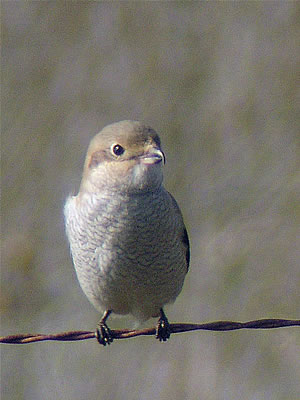
Led a bird walk today at Las Gallinas ponds. Good weather, good people, and good birds! Highlight for many, and a life bird for some, was a juvenile Northern Shrike, found by Bingham Gibb's group as it perched on the fence-line north of pond #3 (the bird perched, not the group). I prefer to send mostly "sharp" photos, but sometimes shots of lesser quality are of interest because of the subject, as here. This bird has been seen intermittently at the ponds for several weeks now. Photo cropped, as distance was 25 yards.
Lanius excubitor, the Northern Shrike is a regular but unusual visitor to California, and more often found in the Central Valley. Usually young birds like this, but sometimes an adult. Shrikes are declining (factors multiple, and not clearly understood), perhaps affecting Loggerhead Shrike more than Northern. Note the pretty wavy lines (vermiculations) on the breast and belly, as well at the dark mask extending back from the eye, and the rather prodigious bill with fearsome hook on the end. Here the bill is foreshortened. Bill used to dispatch vertebrate prey humanely (or should I have said "shrikely"?). Taxonomy below.
Order: Passeriformes - The Perching Birds
Family: Laniidae - Shrikes, aka "Butcher birds". (Lanius from the Latin word lanio, "to butcher". (Holloway). There are 100+ species of "shrikes", if you include Bushshrikes and Helmetshrikes (Humann, in Sibley Guide). We saw many shrikes in Africa years ago. Bushshrikes and Helmetshrikes are really not related to the True Shikes, and should not be placed in the same family (Humann).
Subfamily: Lanninae - "True Shrikes". 29 species. Our other regular one is the Loggerhead Shrike - the Brown Shrike is rarely seen as an accidental. Related to Corvids and Vireos.
Genus: Lanius - Shrike (and Fiscals). 26 species, give or take.
Species: Lanius excubitor - Northern Shrike. Sometimes kills birds as large as itself, but would prefer a field mouse. Able to lift heavy prey, perhaps more so than most raptors. "Excubitor" is a guard or sentinel. Shrikes supposedly alert other birds to larger predators in the area.
TOWHEE.NET: Harry Fuller, 820 NW 19th Street, McMinnville, OR 97128
website@towhee.net